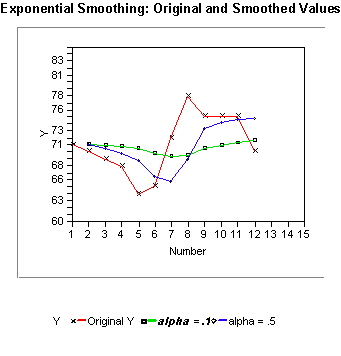|
Exponential smoothing weights past observations with exponentially
decreasing weights to forecast future values
|
This smoothing scheme begins by setting \(S_2\) to \(y_1\),
where \(S_i\)
stands for smoothed observation or EWMA, and \(y\)
stands for the original observation.
The subscripts refer to the time periods, \(1, \, 2, \, \ldots, \, n\).
For the third period, \(S_3 = \alpha y_2 + (1-\alpha) S_2\);
and so on. There is no \(S_1\);
the smoothed series starts with the smoothed version of the second observation.
For any time period \(t\),
the smoothed value \(S_t\)
is found by computing
$$ S_t = \alpha y_{t-1} + (1-\alpha)S_{t-1} \,\,\,\,\,\,\, 0 < \alpha \le 1 \,\,\,\,\,\,\, t \ge 3 \, . $$
This is the basic equation of exponential smoothing and the
constant or parameter \(\alpha\)
is called the smoothing constant.
Note: There is an alternative approach to exponential smoothing
that replaces \(y_{t-1}\)
in the basic equation with \(y_t\),
the current observation. That formulation,
due to Roberts (1959), is described in the section on
EWMA control charts.
The formulation here follows Hunter (1986).
|
|
The first forecast is very important
|
The initial EWMA plays an important role in computing all the
subsequent EWMAs. Setting \(S_2\) to \(y_1\)
is one method of initialization. Another way is to set it to the target of the process.
Still another possibility would be to average the first four or five
observations.
It can also be shown that the smaller the value of \(\alpha\),
the more important is the selection of the initial EWMA. The user would
be wise to try a few methods, (assuming that the software has them
available) before finalizing the settings.
|
|
Summation formula for basic equation
|
By substituting for \(S_{t-2}\),
then for \(S_{t-3}\),
and so forth, until we reach \(S_2\)
(which is just \(y_1\)),
it can be shown that the expanding equation can be written as:
$$ S_t = \alpha \sum_{i=1}^{t-2} (1-\alpha)^{i-1} y_{t-i}
+ (1-\alpha)^{t-2} S_2 \, , \,\,\,\,\, t \ge 2 \, . $$
|


